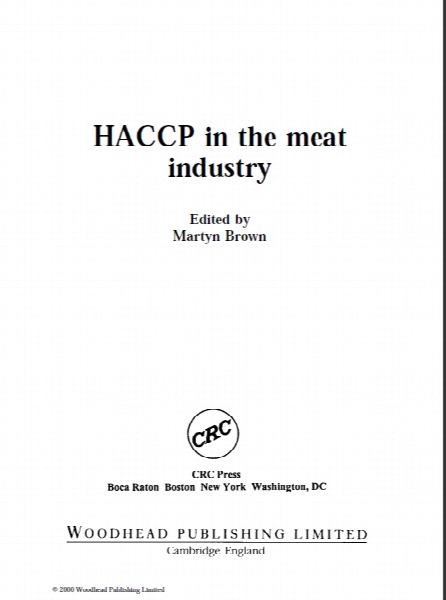HACCP in the meat industry
- نوع فایل : کتاب
- زبان : انگلیسی
- مؤلف : Martyn Brown
- ناشر : Boca Raton, Fla. : CRC Press ; Cambridge, England : Woodhead Pub
- چاپ و سال / کشور: 2000
- شابک / ISBN : 9781591240723
Description
List of contributors Part 1 General issues 1 Introduction T. H. Pennington, University of Aberdeen 1.1 E. coli O157 1.2 HACCP and food safety 1.3 The successful implementation of HACCP 1.4 References 2 The regulatory context in the EU M. Fogden, Meat and Livestock Commission 2.1 Introduction: the international context 2.2 EU food policy and HACCP 2.3 EU meat hygiene legislation and HACCP 2.4 Fishery products 2.5 Future trends 2.6 Sources of further information and advice 2.7 References 3 HACCP in the United States: regulation and implementation L. Crawford, Center for Food and Nutrition Policy, Georgetown University 3.1 Introduction: the regulatory background Contents © 2000 Woodhead Publishing Limited 3.2 Development of HACCP in the United States 3.3 HACCP implementation in practice 3.4 Beyond HACCP 3.5 Bibliography Part 2 HACCP on the farm and in primary processing 4 HACCP and farm production A. M. Johnston, Royal Veterinary College, University of London 4.1 Introduction 4.2 Hazard analysis in animal rearing 4.3 Setting up the HACCP system 4.4 HACCP plans for cattle 4.5 HACCP plans for sheep and goats 4.6 HACCP plans for a poultry unit 4.7 HACCP plans for a pig unit 4.8 Summary: the effectiveness of HACCP on the farm 4.9 References 5 HACCP in primary processing: red meat C. O. Gill, Agriculture and Agri-Food, Canada 5.1 Introduction 5.2 Microbiological data: collection and analysis 5.3 HACCP implementation: the general approach 5.4 Stock reception 5.5 Slaughter and predressing 5.6 Carcass dressing 5.7 Collection and cooling of offals 5.8 Carcass cooling 5.9 Carcass breaking; equipment cleaning 5.10 Smaller plants 5.11 Microbiological criteria 5.12 References 6 HACCP in primary processing: poultry G. C. Mead, Royal Veterinary College, University of London 6.1 Introduction 6.2 Hazard analysis in the slaughter process 6.3 Establishing CCPs 6.4 Other processing operations 6.5 Future trends 6.6 Decontamination of carcasses 6.7 Sources of further information and advice 6.8 References © 2000 Woodhead Publishing Limited Part 3 HACCP tools 7 Microbiological hazard identification in the meat industry P. J. McClure, Unilever Research, Sharnbrook 7.1 Introduction 7.2 The main hazards 7.3 Analytical methods 7.4 Future trends 7.5 Sources of further information and advice 7.6 References 8 Implementing HACCP in a meat plant M. H. Brown, Unilever Research, Sharnbrook 8.1 Introduction 8.2 The elements requiring implementation 8.3 The implementation process 8.4 The differences between large and small businesses 8.5 Where to start with implementation 8.6 Explanation of the reasons for HACCP 8.7 Review of food safety issues 8.8 Planning for implementation 8.9 Allocation of resources 8.10 Selecting teams and activities 8.11 Training 8.12 Transferring ownership to production personnel 8.13 Tackling barriers 8.14 Measuring performance of the plan 8.15 Auditing and review 8.16 Conclusions 8.17 References 9 Monitoring CCPs in HACCP systems J. J. Sheridan, TEAGASC (The National Food Centre), Dublin 9.1 Introduction 9.2 Establishing criteria 9.3 Determination of critical limits 9.4 Setting up monitoring systems 9.5 Verification of HACCP systems 9.6 Validation of the HACCP plan 9.7 Identifying problem areas 9.8 Feedback and improvement 9.9 Future trends 9.10 References © 2000 Woodhead Publishing Limited 10 Validation and verification of HACCP plans M. H. Brown, Unilever Research, Sharnbrook 10.1 Introduction 10.2 The background to validation and verification of HACCP 10.3 How far along the supply chain should a HACCP study extend? 10.4 The importance of Good Manufacturing Practice (GMP) 10.5 Decision making within a HACCP-based QA system 10.6 Monitoring 10.7 Validation, microbiological and other hazards 10.8 Introducing validation and verification 10.9 Validation – is it the right plan? 10.10 Verification – are we doing it correctly? Is it working? 10.11 Reporting conclusions and agreeing an action plan 10.12 Specific additional requirements for the meat industry 10.13 Involvement of plant management in validation and verification 10.14 Involvement of the HACCP team in validation and verification 10.15 How to validate a new HACCP study 10.16 How to validate an implemented HACCP plan 10.17 Sampling plans for validation 10.18 Sampling plans for verification 10.19 Output from validation and verification 10.20 Conclusions 10.21 References 11 Auditing HACCP-based QA systems N. Khandke, Unilever Research, Sharnbrook 11.1 Introduction 11.2 HACCP and quality systems 11.3 Establishing benchmarks for auditing 11.4 What the auditor should look for 11.5 Future trends 11.6 References 12 Moving on from HACCP J.-L. Jouve, Ecole Nationale Veterinaire de Nantes 12.1 Introduction 12.2 Future trends 12.3 Development of a risk-based food safety strategy 12.4 The Food Safety Programme © 2000 Woodhead Publishing Limited 12.5 HACCP revisited: introduction of risk assessment techniques 12.6 Summary 12.7 References
HACCP is a systematic approach to the identification, evaluation, and control of food safety hazards. It is being applied across the world, with countries such as the US, Australia, New Zealand, and the UK leading the way. However, effective implementation in the meat industry remains difficult and controversial. HACCP in the meat industry provides a survey of principles and practices, providing a guide to making HACCP systems work in the meat industry.


